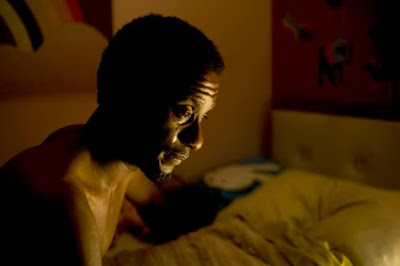
Tonight’s “unveiling" (their word) of emerging talent in the Prospectif Cinéma series at the Pompidou Center was the young Israeli born film and videomaker Omer Fast. He presented his 2009 installation, Nostalgia which was shown at the Whitney Biennial and various other museums and gallery spaces. Before the projection commenced, I was skeptical of seeing a three part video installation on single screen projection in the big upstairs cinema at the Pompidou Center. But my suspicions were quickly allayed when Fast explained what an ideal (if didactic) viewing situation this was. Why, I wondered, did he make it for a gallery space: the South London Gallery?

Different viewers of Nostalgia will say it is about different things. For me, like all of Fast’s work, it’s about story telling above all else. Everyone has a story to tell: the Nigerian interviewed by the (fictional) Fast, the British asylum seeker at the Home Office in Nigeria (!), the refugee who wants to be an actor but doesn’t even have a place to live, and of course, the filmmaker and all his proxies in the film. And as the film proceeds, each story keeps coming back to the same kernel: the story of how to build a trap to catch a partridge. In the Q & A part of tonight’s event, Fast talked about his influences, cinematic influences such as the sci-fi film for its inversion of the aliens and the humans, the good guys and bad guys in the same way Fast performatively inverts the players in the drama at the Home Office – a white British guy from Surrey seeks asylum from a black African woman. Whether or not it counts as one of Fast’s influences, the film that kept coming back to me as I listened to him talk, with Nostalgia fresh in my mind, was Chilean exile, Raúl Ruiz’ Les Trois couronnes du matelot (1983). Everyone in Ruiz film has a story, and everyone tells his story in search of his identity in a world to which he will never belong. The only way to stay alive in Ruiz' surreal fantasy is to spin yarns, their veracity being irrelevant. And for all the eccentrics in the film, the story is not only their identity, it is their only possession.

Across the three parts of Nostalgia, Fast has his characters, characters that hover on the boundary between documentary and fiction, attempt again and again to tell their story. And their stories are passed on to each other, passed through the narrative of Fast’s film, all coming full circle to how to make a trap for a partridge. But in Fast’s world, something always interrupts—typically someone or some thing that has power over the one trying to spin his or her tale. In the second part, for example, the character which is a fictional Fast, won’t let the refugee tell his story, always pushing him to paint the picture he has in mind for his film. And for the man from Surrey, to tell his story is to betray his compatriots who will be smuggled via the tunnel he once used to migrate. And so, no one ever belongs, no one fully evades the impending death of having their story left untold. If, like the sailors in Ruiz' film, the story is the only possession and the only identity, then there is something very brutal, something not always shown in the images, about a world that won’t let its citizens tell their stories.

The most disturbing interruption into the narratives is that of the film itself. Because Nostalgia is also a narration of the way stories are made, the way film always searches for the truth of an ultimately impenetrable reality—in this case the past and the memories of the African immigrant community in southwest London. And as the film narrates this process of its own storytelling across the three parts, the quality of the image deteriorates, as though the camera is lost in its search for something it doesn’t really understand. The camera work becomes looser, the image quality more gritty. Experiencing this very gradual loss of orientation, and simultaneous contamination of the stories, particularly, that of the partridge trap, is the reward of watching Nostalgia I, II and III from beginning to end at the Pompidou Center cinema. Seen as looped videos, on multi-channel screens, having to navigate through a tunnel in the unique space of the South London Gallery would, I imagine bring a whole new, though not necessarily impoverished, experience.
No comments:
Post a Comment